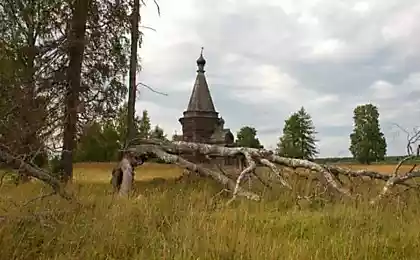242
Sterch is a white crane

Who didn’t die when they heard cranes in the sky? Most likely, each of us at this moment is looking for wedges in the sky of these majestic birds. In the European part of Russia, we most often see gray cranes, which can be seen not only during migrations in flight, but in the spring-summer period walking in fields and meadows. However, today we will talk about the rarest cranes in Russia - sterch, or white cranes (Grus leucogeranus). Sterch is a sacred bird of the Khanty people inhabiting the north of Western Siberia.
Sterch is a large bird with a typically crane appearance, almost entirely white - only the ends of the wings are black. The beak, the area of bare skin on the head, as well as the paws of this crane is red in color. Sexual dimorphism is expressed in the overall size and length of the beak (male are larger than females). Bitches from birth have a pretty red color.
Sterch, a white crane (Grus leucogeranus). Photo by Dahai Z.
Despite all its grace and beauty, white cranes are absolutely unsociable. They do not tolerate even the slightest concern, which is the main factor in its disappearance. During the nesting period, a pair of these cranes can drop masonry if they notice people or helicopters in the breeding area even at a considerable distance from the nest. This feature of the sterkhs has long been known by the indigenous people of Siberia - the Khanty, they forbade their hunters to visit the swamps during the nesting period of cranes.
Adult bitch in the sky. Photo by Gunnar Pettersson.
White cranes are recognized as the most territorial and aggressive birds among their relatives. The density of nesting horns is impressive – couples build nests as remotely as possible from each other. The average distance between the nests of sterkhs of the Yakut population is 14-20 km (from 2.5 km to 75 km). Ob horns nest a little closer to each other (from 1.5 to 10 km). All the behavior of cranes is highly ritualized - the demonstration of threatening postures allows you to avoid fights during reproduction and maintains a strict hierarchy on wintering sites.
Sterch is endemic to Russia and is represented by two geographical populations – eastern (Yakut) and western Siberian (Ob). The latter is currently in an extremely critical condition, its population does not exceed 20 individuals. The Yakutian nesting group of sterkhs numbers from 300 to 3,000 birds according to various sources. As already mentioned, sterchs nest only in Russia. Ob sturkhs inhabit the steppes of Western Siberia, and Yakut nest in the most inaccessible swamps of the tundra, forest tundra and the northern part of the taiga. A prerequisite for the life of both populations of sterchs is the presence of reservoirs – permanent, such as lakes, as well as temporary – declines, flooded by seasonal floods.
A pair of white cranes in the sky. Photo by Gunnar Pettersson.
Skurkhi winter on the territory of India, Iran, as well as in the southeast of China. Birds during flights overcome huge distances (about 6 thousand km).
White cranes feed mainly on plant food - various parts of sedges and cereals, as well as all available seeds and berries. During the breeding period, sterchi do not pass by small rodents, mollusks and insects.
The young sterch filters the seeds. Photo by John Wright.
Biology of reproduction of sterchs in the natural environment The typical monogams. Permanent pairs are formed at the age of 6-7 years, when the birds become sexually mature. Reproduction is preceded by marriage dances, when a pair of white cranes in unison makes high jumps and runs with outstretched wings. Nests are built directly on open water in the form of well-stamped platforms from sedge stems. Nests can be used for several years. Sterch laying consists of 1-2 eggs, which is incubated mainly by a female for about 27-28 days. The hatched chicks are extremely aggressive, so immediately after birth they fiercely fight each other. Usually the older chick kills the weaker youngest. The fact of such fratricide in the biology of reproduction of these birds, as well as the low percentage of breeding pairs, along with sensitivity to anxiety, causes a low number of sterchs in nature.
Teen sterch fisherman. Photo by John Wright.
However, it happens that both chicks survive, this happens if the first hatched chick is immediately taken away from the nest by one of the parents, and the second after birth (1-3 days) is brought up by the other parent, the family unites in about a month, when the aggressiveness of the chicks comes to naught. There is almost no development data erased in the natural environment.
White cranes are listed in the Red Books of Russia and the IUCN (International Union for Conservation of Nature), as a species threatened with complete extinction. Scientists are very concerned about the state of sterch and for several decades there has been intensive international work to preserve and restore the wild population of white cranes. First of all, with the assistance of international environmental organizations, a network of reserves was created in its nesting, wintering and migration stops, where all opportunities are used to preserve biotopes suitable for these birds, and, of course, to reduce the concern factor. Unfortunately, it is not possible to preserve the sterch everywhere - there is information that sterchs, like other cranes, are still hunted on wintering grounds in Iran and India.
The first flights of a young white crane. Photo by Hiyashi Haka.
The next stage in the preservation of these beautiful birds was the introduction of young sterchs raised in special conditions of captivity.
In Russia, the project for the introduction of sterch into the wild began its existence in the 90s of the last century. Since then, more than 100 chicks have been released into nature. Studies of scientists have shown that the survival rate of artificially reared chicks is no more than 20%, at first glance, little, but if you consider that in nature in the first year of life survives only 30% of the sternum born in freedom, this is a serious contribution to the preservation of the sterch.
Adult white crane (sterch). Photo by Kai Xie.
Interestingly, initially to create a parent stock in nurseries, ornithologists removed one egg from the nests of the sterch in nature and incubated them artificially. Now the eggs of sterchs from nurseries are placed in the nests of gray cranes that breed in the same places as the sterchs - this method of introduction was called the method of foster parents.
The sterch family is a pair of parents and a descendant. Photo by Gunnar Pettersson.
The most famous project for the introduction of white cranes "Flight of Hope", or the method of isolated raising sterch chicks in captivity. Sterches are brought up in special nurseries, whose employees at any contact with chicks are dressed in a special white suit, where one sleeve is made in the form of the head of an adult sterch. They walk stershats, teach them to fly and find food on their own. The most difficult thing with this method of induction into the wild is to get young women skills for long flights and orientation during migrations. Experts have found a way out of this situation - now the horns fly on their first trip to winter with the help of special man-controlled motodeltagliders. Young cranes take the aircraft for their leader and fly after him to the first migratory clusters of cranes, where they mix with wild birds and then fly with their relatives.
Interesting facts about sterchs - sterchs in the nesting period sleep no more than 2 hours a day.
The life expectancy of sterchs is known only from the data of the content of these birds in captivity - 80 years.
Sterchy, surprisingly, is quite a frequent view in the collections of major zoos in the world. They reproduce quite successfully in captivity, however, despite this, problems with their content in captivity white cranes deliver a lot. Especially for the people who feed them. The fact is that females raised in captivity perceive people as individuals of their species. And, based on their aggressiveness and territoriality, the sexually mature couple does not tolerate anyone in their enclosure and seeks to kill any living creature that has entered their territory. The impacts of the beak and legs of cranes are so strong that they can break the spine of small predators, for example, a fox. Very interesting material about the experience of keeping sterkhs in captivity is on the website of the Moscow Zoo.
In 2012, the head of our state V.V. Putin took part in the Flight of Hope project. He on a motodeltaglider, purchased at his own expense, flew with 7 young white cranes to one of the places of migration stops of gray cranes. Unfortunately, the gray cranes this time did not take stershats, and they had to be returned to the nursery. By the way, it will be said that V.V. Putin presented his motodeltaglider to scientists working on the project of saving the sterkhs. Importantly, thanks to the president’s participation in Flight of Hope, a huge number of people have learned who the horns are and why they should be kept.
Julia Grishanova
Source: natureworld.ru/






















